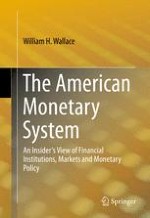2013 | OriginalPaper | Buchkapitel
8. Who Finances American Industry? The Relative Roles of Commercial and Investment Banking
verfasst von : William H. Wallace
Erschienen in: The American Monetary System
Aktivieren Sie unsere intelligente Suche, um passende Fachinhalte oder Patente zu finden.
Wählen Sie Textabschnitte aus um mit Künstlicher Intelligenz passenden Patente zu finden. powered by
Markieren Sie Textabschnitte, um KI-gestützt weitere passende Inhalte zu finden. powered by
